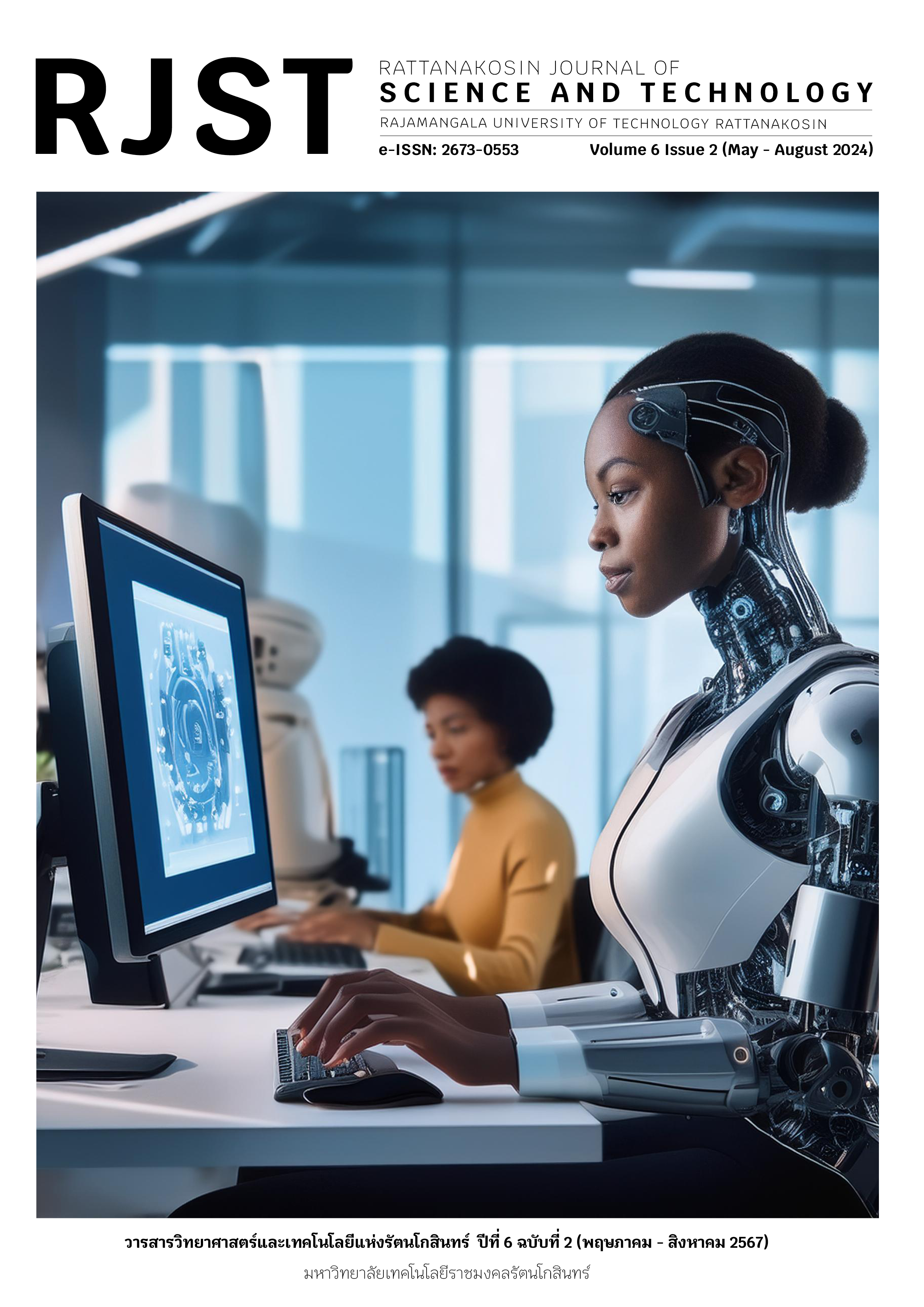The effect of natural fibers and para rubber latex on adobe bricks
Main Article Content
Abstract
The aim of this study was to enhance the strength and water resistance of adobe bricks through the combination of natural fibers and para rubber latex. The initial mixing ratio of the ingredients consisted of clay: rice husk: sand in proportions of 6: 0.72: 2 by weight. Para rubber latex is mixed with 10% of the weight of the soil in mixtures containing latex. Natural fibers such as rice husk or coconut fibers replace rice husk at a rate of 4.5% of the soil weight. The materials were compressed into wooden molds measuring 10 cm in width, 35 cm in length, and 17.5 cm in height. This study aimed to simulate real conditions in curing bricks under the sun for 21 and 28 days without using plastic wrapping. The bricks were subjected to tests for compressive strength, flexural strength, and erosion at 21 and 28 days of curing. The results of the tests showed that the addition of para rubber latex or various types of natural fibers to the adobe bricks enhanced their properties.
Article Details

This work is licensed under a Creative Commons Attribution-NonCommercial-NoDerivatives 4.0 International License.
The content within the published articles, including images and tables, is copyrighted by Rajamangala University of Technology Rattanakosin. Any use of the article's content, text, ideas, images, or tables for commercial purposes in various formats requires permission from the journal's editorial board.
Rajamangala University of Technology Rattanakosin permits the use and dissemination of article files under the condition that proper attribution to the journal is provided and the content is not used for commercial purposes.
The opinions and views expressed in the articles are solely those of the respective authors and are not associated with Rajamangala University of Technology Rattanakosin or other faculty members in the university. The authors bear full responsibility for the content of their articles, including any errors, and are responsible for the content and editorial review. The editorial board is not responsible for the content or views expressed in the articles.
References
Malai, A., & Khamput, P. (2006). Development of Rubber Natural Concrete Block for Thermal Insulation and Energy Saving Purpose. In The 2nd Joint International Conference on “Sustainable Energy and Environment (SEE 2006)”, Bangkok, Thailand (pp. 1009-1014).
Prachoom, K. (2006). A-23 using latex from para-rubber for developing strength and thermal insulation properties of concrete block (Session: Inorganic Materials). In ASMP: proceedings of Asian Symposium on Materials and Processing (Vol. 2006, p. 23).
Kroehong, W., Jaturapitakkul, C., Pothisiri, T., & Chindaprasirt, P. (2018). Effect of oil palm fiber content on the physical and mechanical properties and microstructure of high-calcium fly ash geopolymer paste. Arabian Journal for Science and Engineering, 43, 5215-5224.
phatpun, phiraphong, & Chaisakulkiet, U. (2023). Mechanical Properties of Lightweight Concrete Mixed with Palm Ash Reinforced with Palm Bunch Fibers by Steam Curing Method. Rattanakosin Journal of Science and Technology, 5(3), 58–66. Retrieved from https://ph02.tci-thaijo.org/index.php/RJST/article/view/249284
Eslami, A., Mohammadi, H., & Banadaki, H. M. (2022). Palm fiber as a natural reinforcement for improving the properties of traditional adobe bricks. Construction and Building Materials, 325, 126808.,
https://doi.org/10.1016/j.conbuildmat.2022.126808.
L. Miccoli, A. Garofano, P. Fontana, & U. Müller, (2015). Experimental testing and finite element modelling of earth block masonry, Engineering Structures. 104,80–94.
G. Araya-Letelier, F.C. Antico, C. Burbano-Garcia, J. Concha-Riedel, J. Norambuena-Contreras, J. Concha, & E.I. Saavedra Flores, (2021). Experimental evaluation of adobe mixtures reinforced with jute fibers, Construction and Building Materials. 276 122127, https://doi.org/10.1016/j.conbuildmat.2020.122127.
H. Van Damme, & H. Houben, (2018). Earth concrete, Stabilization revisited. Cement and Concrete Research. 114. 90–102.
Promluangsri, P. & Wongpa, J. (2015). A Development of Adobe Brick Made from Loess. The 20th National Convention on Civil Engineering. 8-10 July 2015:1-7.
Promluangsri, P., Wongpa, J. & Raungrut, C. (2017). A Study on Properties of Adobe Brick Mixed with Asphalt Emulsion under Continuous Submergence Condition. Rajabhat Rambhai Barni Research Journal. 11:130-138.
NZS 4297:1998, Engineering Design of Earth Buildings, Standards New Zealand.
TIS 77-2545. Ordinary building brick products. Thai Industrial Standard. Thailand.
ASTM C67, (2016). Standard Test Methods for Sampling and Testing Brick and Structural Clay Tile. Annual Book of ASTM Standards. USA.
Heathcote, K. (2002). An Investigation into the Erosion of Earth Walls. PhD Thesis. University of Technology: Sydney, Australia.
NZS 4299:1998, Earth Buildings Not Requiring Specific Design, Standards New Zealand.
Wongpa, J. & Thongsanitgarn, P, (2018). Effect of Para rubber latex and coir on compressive strength, water absorption and volumetric change of adobe brick. International Journal of Agricultural Technology. 14(7) 2229-2240. https://doi.org/10.14456/mijet.2022.4
Picuno, P. (2016). Use of traditional material in farm buildings for a sustainable rural environment. International Journal of Sustainable Built Environment, 5(2), 451-460. https://doi.org/10.1016/j.ijsbe.2016.05.005
Illampas, R., Ioannou, I., & Charmpis, D. C. (2014). Adobe bricks under compression: Experimental investigation and derivation of stress–strain equation. Construction and Building Materials, 53, 83-90. https://doi.org/10.1016/J.CONBUILDMAT.2013.11.103
Caballero-Caballero, M., Chinas-Castillo, F., Montes Bernabé, J. L., Alavéz-Ramirez, R., & Silva Rivera, M. E. (2018). Effect on compressive and flexural strength of agave fiber reinforced adobes. Journal of natural fibers, 15(4), 575-585. https://doi.org/10.1080/15440478.2017.1349709
Araya-Letelier, G., Antico, F. C., Burbano-Garcia, C., Concha-Riedel, J., Norambuena-Contreras, J., Concha, J., & Flores, E. S. (2021). Experimental evaluation of adobe mixtures reinforced with jute fibers. Construction and Building Materials, 276, 122127. https://doi.org/10.1016/J.CONBUILDMAT.2020.122127


